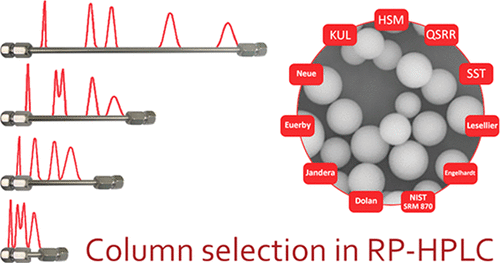当前位置:
X-MOL 学术
›
Chem. Rev.
›
论文详情
Our official English website, www.x-mol.net, welcomes your feedback! (Note: you will need to create a separate account there.)
Column Characterization and Selection Systems in Reversed-Phase High-Performance Liquid Chromatography.
Chemical Reviews ( IF 62.1 ) Pub Date : 2019-01-03 , DOI: 10.1021/acs.chemrev.8b00246 Petar Žuvela 1 , Magdalena Skoczylas 2 , J Jay Liu 3 , Tomasz Ba Czek , Roman Kaliszan , Ming Wah Wong 1 , Bogusław Buszewski 2 , Károly Héberger
Chemical Reviews ( IF 62.1 ) Pub Date : 2019-01-03 , DOI: 10.1021/acs.chemrev.8b00246 Petar Žuvela 1 , Magdalena Skoczylas 2 , J Jay Liu 3 , Tomasz Ba Czek , Roman Kaliszan , Ming Wah Wong 1 , Bogusław Buszewski 2 , Károly Héberger
Affiliation

|
Reversed-phase high-performance liquid chromatography (RP-HPLC) is the most popular chromatographic mode, accounting for more than 90% of all separations. HPLC itself owes its immense popularity to it being relatively simple and inexpensive, with the equipment being reliable and easy to operate. Due to extensive automation, it can be run virtually unattended with multiple samples at various separation conditions, even by relatively low-skilled personnel. Currently, there are >600 RP-HPLC columns available to end users for purchase, some of which exhibit very large differences in selectivity and production quality. Often, two similar RP-HPLC columns are not equally suitable for the requisite separation, and to date, there is no universal RP-HPLC column covering a variety of analytes. This forces analytical laboratories to keep a multitude of diverse columns. Therefore, column selection is a crucial segment of RP-HPLC method development, especially since sample complexity is constantly increasing. Rationally choosing an appropriate column is complicated. In addition to the differences in the primary intermolecular interactions with analytes of the dispersive (London) type, individual columns can also exhibit a unique character owing to specific polar, hydrogen bond, and electron pair donor-acceptor interactions. They can also vary depending on the type of packing, amount and type of residual silanols, "end-capping", bonding density of ligands, and pore size, among others. Consequently, the chromatographic performance of RP-HPLC systems is often considerably altered depending on the selected column. Although a wide spectrum of knowledge is available on this important subject, there is still a lack of a comprehensive review for an objective comparison and/or selection of chromatographic columns. We aim for this review to be a comprehensive, authoritative, critical, and easily readable monograph of the most relevant publications regarding column selection and characterization in RP-HPLC covering the past four decades. Future perspectives, which involve the integration of state-of-the-art molecular simulations (molecular dynamics or Monte Carlo) with minimal experiments, aimed at nearly "experiment-free" column selection methodology, are proposed.
中文翻译:

反相高效液相色谱中的色谱柱表征和选择系统。
反相高效液相色谱(RP-HPLC)是最流行的色谱模式,占所有分离的90%以上。HPLC本身因其相对简单和廉价,设备可靠且易于操作而广受欢迎。由于具有广泛的自动化功能,即使是技术相对较低的人员,它也可以在不同的分离条件下几乎无人值守地运行多个样品。当前,有> 600 RP-HPLC色谱柱可供最终用户购买,其中一些色谱柱的选择性和生产质量差异很大。通常,两个相似的RP-HPLC色谱柱并不均等地适合于所需的分离,并且迄今为止,还没有通用的RP-HPLC色谱柱覆盖多种分析物。这迫使分析实验室保留大量不同的色谱柱。因此,色谱柱的选择是RP-HPLC方法开发的关键部分,特别是因为样品的复杂性一直在增加。合理选择合适的列很复杂。除了与分散型(伦敦)类型的分析物之间的主要分子间相互作用不同之外,由于特定的极性,氢键和电子对供体-受体相互作用,各个色谱柱也可以显示出独特的特性。它们还可以根据填充类型,残余硅烷醇的量和类型,“封端”,配体的键合密度和孔尺寸等而变化。因此,取决于所选色谱柱,RP-HPLC系统的色谱性能通常会发生很大变化。尽管可以在此重要主题上获得广泛的知识,但仍然缺乏针对色谱柱的客观比较和/或选择的全面综述。我们的目标是使本综述成为涵盖过去四十年中有关RP-HPLC中色谱柱选择和表征的最相关出版物的全面,权威,关键且易于阅读的专着。提出了未来的观点,这些观点涉及将最先进的分子模拟(分子动力学或蒙特卡洛)与最少的实验相结合,旨在实现几乎“无实验”的色谱柱选择方法。我们的目标是使本综述成为涵盖过去四十年中有关RP-HPLC中色谱柱选择和表征的最相关出版物的全面,权威,关键且易于阅读的专着。提出了未来的观点,这些观点涉及将最先进的分子模拟(分子动力学或蒙特卡洛)与最少的实验相结合,旨在实现几乎“无实验”的色谱柱选择方法。我们的目标是使本综述成为涵盖过去四十年中有关RP-HPLC中色谱柱选择和表征的最相关出版物的全面,权威,关键且易于阅读的专着。提出了未来的观点,这些观点涉及将最先进的分子模拟(分子动力学或蒙特卡洛)与最少的实验相结合,旨在实现几乎“无实验”的色谱柱选择方法。
更新日期:2019-01-03
中文翻译:

反相高效液相色谱中的色谱柱表征和选择系统。
反相高效液相色谱(RP-HPLC)是最流行的色谱模式,占所有分离的90%以上。HPLC本身因其相对简单和廉价,设备可靠且易于操作而广受欢迎。由于具有广泛的自动化功能,即使是技术相对较低的人员,它也可以在不同的分离条件下几乎无人值守地运行多个样品。当前,有> 600 RP-HPLC色谱柱可供最终用户购买,其中一些色谱柱的选择性和生产质量差异很大。通常,两个相似的RP-HPLC色谱柱并不均等地适合于所需的分离,并且迄今为止,还没有通用的RP-HPLC色谱柱覆盖多种分析物。这迫使分析实验室保留大量不同的色谱柱。因此,色谱柱的选择是RP-HPLC方法开发的关键部分,特别是因为样品的复杂性一直在增加。合理选择合适的列很复杂。除了与分散型(伦敦)类型的分析物之间的主要分子间相互作用不同之外,由于特定的极性,氢键和电子对供体-受体相互作用,各个色谱柱也可以显示出独特的特性。它们还可以根据填充类型,残余硅烷醇的量和类型,“封端”,配体的键合密度和孔尺寸等而变化。因此,取决于所选色谱柱,RP-HPLC系统的色谱性能通常会发生很大变化。尽管可以在此重要主题上获得广泛的知识,但仍然缺乏针对色谱柱的客观比较和/或选择的全面综述。我们的目标是使本综述成为涵盖过去四十年中有关RP-HPLC中色谱柱选择和表征的最相关出版物的全面,权威,关键且易于阅读的专着。提出了未来的观点,这些观点涉及将最先进的分子模拟(分子动力学或蒙特卡洛)与最少的实验相结合,旨在实现几乎“无实验”的色谱柱选择方法。我们的目标是使本综述成为涵盖过去四十年中有关RP-HPLC中色谱柱选择和表征的最相关出版物的全面,权威,关键且易于阅读的专着。提出了未来的观点,这些观点涉及将最先进的分子模拟(分子动力学或蒙特卡洛)与最少的实验相结合,旨在实现几乎“无实验”的色谱柱选择方法。我们的目标是使本综述成为涵盖过去四十年中有关RP-HPLC中色谱柱选择和表征的最相关出版物的全面,权威,关键且易于阅读的专着。提出了未来的观点,这些观点涉及将最先进的分子模拟(分子动力学或蒙特卡洛)与最少的实验相结合,旨在实现几乎“无实验”的色谱柱选择方法。



























 京公网安备 11010802027423号
京公网安备 11010802027423号